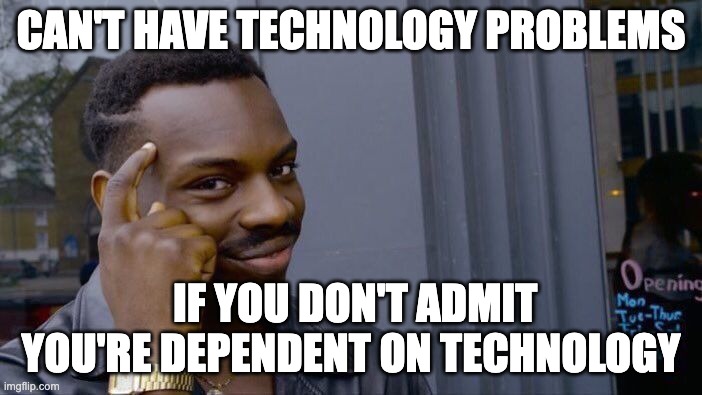The Great Illusion
There exists a peculiar disconnect in how businesses perceive themselves. Visit the headquarters of a luxury perfume brand, an educational institution, or a manufacturing plant, and ask them if they're a tech company. The answer will likely be an emphatic "No," followed by a clarification of their true identity: "We're in fragrance," "We're educators," or "We're industrial manufacturers."
This rejection of the tech label persists despite the fact that software permeates every aspect of their operations. This isn't mere semantics—it reflects a fundamental misunderstanding about the role of technology in modern business, one that can have profound strategic implications.

The Omnipresence of Software
Take a moment to consider any business, regardless of industry. Look closely enough, and you'll find software at every turn. The luxury perfume brand uses specialized software to track ingredient sourcing, manage formula development, coordinate production schedules, and analyze customer purchasing patterns. Educational institutions deploy learning management systems, student information databases, and digital assessment tools. Manufacturing plants operate with sophisticated control systems, inventory management platforms, and predictive maintenance algorithms.
This reality extends to every conceivable sector. Restaurants use point-of-sale systems and inventory management software. Healthcare providers manage patient records through electronic health record systems. Agricultural operations deploy precision farming software to optimize crop yields. Even the most traditional businesses—bakeries, plumbing services, tailor shops—rely on accounting software, customer relationship management tools, or online appointment scheduling systems.
The Software Integration Spectrum
The integration of software into business operations typically follows one of three paths:
-
Externalized through SaaS solutions: Many companies opt for ready-made software solutions available as a service. They subscribe to platforms like Salesforce for customer relationship management, Workday for HR functions, or industry-specific tools that handle specialized needs.
-
Custom-developed externally: When off-the-shelf solutions won't suffice, businesses engage technology partners to build customized software. This approach allows for tailored functionality without requiring in-house technical expertise.
-
Internal development: Some organizations maintain their own software development teams, creating proprietary tools that provide competitive advantages through unique capabilities or integration with existing systems.
Regardless of the approach, the outcome is the same: software becomes an essential business component.
The Identity Crisis
Despite this reality, many businesses actively distance themselves from the "tech company" label. This resistance stems from several factors:
First, there's the matter of brand identity. A luxury fashion house wants to be associated with creativity, craftsmanship, and heritage—not algorithms and databases. An automotive manufacturer wants to evoke engineering excellence and driving experiences—not code repositories and API endpoints.
Second, there's a strategic avoidance of technology-related responsibilities. By positioning themselves outside the tech sphere, companies can sometimes deflect complex questions about data security, technology integration, or digital transformation. "That's not our core business," becomes a convenient shield against deeper technical scrutiny.

Finally, there's the dismissive attitude captured in phrases like "It's not rocket science." This perspective trivializes the complexity of software development and integration, suggesting that technology is a subordinate concern rather than a central business component.
The Reality of Complexity
The truth is that any subject becomes remarkably complex when examined in depth. Software is no exception. Whether you're developing an internal tool for tracking employee performance or implementing an enterprise-wide customer relationship management system, the process invariably involves intricate challenges.
The complexity level depends partly on the subject matter itself. Financial services software must navigate regulations, security requirements, and data integrity concerns. Healthcare applications must ensure patient privacy, regulatory compliance, and potentially life-critical accuracy.
However, complexity is also shaped by the team driving the project. Their technical expertise, understanding of the business domain, communication effectiveness, and collaborative capabilities all influence how well software serves its intended purpose.
Embracing the Tech Reality
The reluctance to acknowledge the technological underpinnings of modern business isn't merely philosophical—it has practical consequences. Companies that fail to recognize their dependence on software often underinvest in technology infrastructure, neglect digital talent development, and miss opportunities for innovation through emerging technologies.

Perhaps most critically, they maintain an artificial separation between "business strategy" and "technology strategy," when these have become inseparable in today's environment.
The more productive approach is to embrace the reality that every company operates at the intersection of its core domain expertise and technology. The perfume brand is indeed in the fragrance business—but it's also in the business of leveraging technology to create, market, and sell those fragrances more effectively.
This acknowledgment doesn't diminish the company's primary identity. Rather, it recognizes that in today's business landscape, the means (technology) has become so integral to the subject (the core business) that the two cannot be meaningfully separated.
Whether they embrace the label or not, every modern company is, to some degree, a technology company. The sooner businesses recognize this truth, the better positioned they'll be to thrive in an increasingly digital future.

